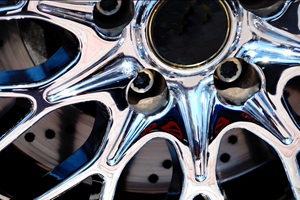Uniform Thickness Distribution of Brush Plating
Q. Why isn’t my brush-plated deposit uniformly distributed? Derek Vanek from Sifco says in order to achieve uniform deposit thickness, a well-designed, properly-used plating tool is critical.
Q. Why isn’t my brush-plated deposit uniformly distributed?
A. The key to uniform thickness distribution is uniform current distribution. Fundamental laws of electrochemistry (i.e. current distribution) do not always allow for a uniform deposit. Direct current always seeks the path of least resistance from the anode to the cathode (substrate/workpiece). As a result, paths of least resistance, such as sharp edges or protrusions, will receive a heavier deposit, while areas such as internal corners/radii receive a significantly less amount of deposit.
The goal of the plater and designer is to provide for the least amount of thickness variation across a workpiece. Design considerations include anode design (geometry, masking and tool movement), workpiece masking and thieving, and bath variables (current density, temperature, additives and flow distribution) to name a few. Here, we’ll focus primarily on anode design.
Selective brush plating is a method that electroplates controlled thicknesses of deposits onto commonly used base materials for industrial components.
As the name implies, the process is focused on a specific area of a component. The area to be plated—as well as adjacent areas to be masked—are first cleaned with a suitable solvent. The part is then masked to isolate the area to be plated and to protect the adjacent areas from the effects of the chemical processes. Typical masking materials include aluminum and vinyl tapes, masking paints and special fixtures.
The selective brush plating process consists of several preparatory steps in which the work area is electrochemically prepared to receive an adherent final deposit, the thickness of which is controlled by ampere-hours: Factor × Area × Thickness = Ampere Hours.
- The factor is a well-established plating rate that is specific to a plating solution. It is the ampere-hours required to deposit the volume of metal equivalent to one-inch thickness onto one square inch of area.
- The area is the total surface area to be plated.
- The thickness is the desired deposit thickness after plating.
Uniform distribution is primarily achieved by proper selection, design, and use of the plating tool, as well as by proper masking of the application.
Covering the full length of an OD, ID, or flat surface with a tool makes it relatively easy to obtain a uniform thickness. When the tool does not cover the full length, problems arise. Take for example the case of attempting to plate a 3" long OD with a tool that will cover 2" of the length. If the tool is moved as shown on top, center of Figure 1, the center 1" is always covered. At the ends, there is less coverage time. A deposit distribution results, as shown at the bottom. The alternative is to move the tool, shown on the left of Figure 1. An even deposit distribution is obtained, but time is wasted with the tool off the part. This motion may also not be practical if there is a shoulder at one side.
The same situation applies to ID and flat surfaces. Always try to have the tool cover the full length of OD or ID, or the full length or width of a flat surface. The anode can be further masked along the outside perimeter with slight overlap onto the work surface to minimize the deposit buildup along the edges of the workpiece.
When the tool is moved, more plating is obtained in the center and less at the ends. When the tool is moved as shown on the lower left of Figure 1, a uniform deposit is obtained, but time is wasted with the tool off the part.
Another consideration for deposit uniformity is ensuring an even distribution of plating solution over the area being plated. For best results, the plating solution should be pumped to the work area through the plating tool and uniformly distributed over the work area. An uneven distribution of fresh solution over the work area will result in an uneven deposit thickness.
In order to achieve uniform deposit thickness, a well-designed, properly-used plating tool is critical.
Other factors to consider:
- The thicker the deposit, the more difficult to plate a tight tolerance.
- It is easier to accurately plate on a small area than a large area.
- It is easier to hold tight tolerances on simple shapes with no interruptions than complex shapes or shapes with interruptions or a large percentage of high current density edge areas.
- Mechanical movement of the part or the anode is going to produce more consistent results than hand movement.
- It is easier to accurately plate a low thickness on a small area than to plate high thickness on a large area.
Originally published in the December 2016 issue.
Related Content
Successful South African Plater Beating the Odds
Remaining focused on quality and reliability, Team Plating Works stays profitable in a volatile and challenging economy.
Read MoreAn Overview of Electroless Nickel Plating
By definition, electroless plating is metal deposition by a controlled chemical reaction.
Read MoreLiquid Chrome Vs. Chromic Acid Flake
Contemplating how to continue offering chromic acid services in an increasingly stringent regulatory world? Liquid chrome products may be the solution you’re looking for.
Read MoreA Chromium Plating Overview
An overview of decorative and hard chromium electroplating processes.
Read MoreRead Next
A ‘Clean’ Agenda Offers Unique Presentations in Chicago
The 2024 Parts Cleaning Conference, co-located with the International Manufacturing Technology Show, includes presentations by several speakers who are new to the conference and topics that have not been covered in past editions of this event.
Read MoreDelivering Increased Benefits to Greenhouse Films
Baystar's Borstar technology is helping customers deliver better, more reliable production methods to greenhouse agriculture.
Read MoreEducation Bringing Cleaning to Machining
Debuting new speakers and cleaning technology content during this half-day workshop co-located with IMTS 2024.
Read More















.jpg;maxWidth=300;quality=90)









